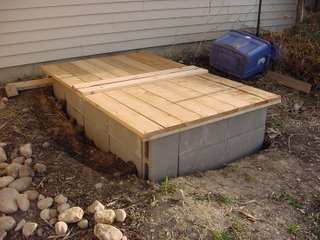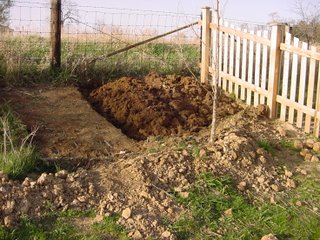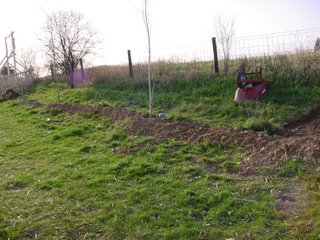I am not a card carrying member of this Slow Food movement, but from what I have seen the idea is great. Buy foods that are in season, locally produced and ensure that it is prepared wholesomely. Big Fan.
When I sold my Evo, the automotive antipathy of the Slow Food movement, and purchased my Insight I knew that some things would be changing. One of the first was that I took up bread baking. I have a history of putting function over form-and my culinary exploits are no exception. Last fall I had dabbled in bread baking again, but I was working under the assumption that I could indeed create a bread that you could live on alone-so they were rock hard and incredibly dense. Other than using 100% whole wheat flour, my biggest problem seemed to be, in hindsight, that I was trying to cram in the full recommended amounts of flour, but I digress.
My Father has made bread by hand for years, and it is the lightest, fullest bread you will ever taste. Over the years he has accumulated a fair library on bread making and in Feburary my Mother recommended that I read
Bread Alone and lent me Dad's copy. This book struck cords that resonated deep within me. Author Daniel Leader was a successful chef in New York, but as his acclaim grew he got further and further from what he really wanted to do, which was to make good wholesome food. In a trip to Europe he had ended up in a French bakery and the result of the time he spent there was for him to quit the chef gig, and set himself up as a baker in rural New York making bread's the Old time honored way-waking up in the middle of the night, using organic grains, and wood fired ovens. I made his 'practice bread' the day after reading his book. Talk about slow food? This bread took 10 hours! Most of the time it is sitting in the corner patiently rising, but still it forces you home for the day. Other than the unbelievable taste, this single trait maybe the reason we have been eating my bread almost exclusively. My son loves to help me knead: he is my 'whoosher' throwing some flour under the dough as I knead, and my daughter is growing in competence at adding flour as I stir. They are covered from head to toe in flour when we're done-but its worth it to have spent a real 3o minutes together as a family with nothing plugged in.
After the practice loaf-I made the sourdough. This may be the slowest food of all as the first loaf took a week. First I had to Stalk the Wild Yeast-having made bread on and off for several months, I had inadvertently impregnated the air with yeast spores that had gone Rogue and it was time to recapture them. I was incredulous... Put some flour and water in a bowl and let it sit for 3 days and I will have yeast? Sounded like a recipe for mold, but I did it and sure enough each day as I added more flour the
chef was changing and by Day 3 it has a distinct sour tang to it. Success! But the baking was still two days off. I had to make the
levain -the starter which would take another day. When it was done the loaves were fantastic-and it was unbelievably simple. Not the process, which is intimidating at first glance, but the ingredients: flour, water and salt. That's it. No fat, no eggs, no anything. Glorious! This recipe has been in use in France for at least 300 years-that connection with history is so important and a valuable tool in battling the hubris of our modern society. I have since tried to apply my inner calling to modify and improve on anything I touch. Results? The new
boulanger motto in our house is don't f#$% with the sour dough-it is perfect as is.
As we have been dieting of late and paying more attention to what we are eating, my wife has made a subtle shift in our shopping-she has begun to place much more emphasis on where our food is coming from. This has many roots, probably started with us working a CSA in 2004 and reaching fruition in environmental impact of what it takes for us to eat strawberries in December. How far has that berry traveled? What did they have to do to it to get it to stand up traveling across two hemispheres? The most immediate effect of this shift is that we are eating vegetables we had not before-like Kale. I ama vegetarian, and I love to garden, but I have trouble with leaves that aren't lettuce. Even Spinach. I am working on that, but this Kale was out there in my book. But our local(ish) choices are limited in March in WI. So we are eating a lot of winter crops-potatoes, onions, Kale, etc. We had a wonderful Culcannon stew, dubbed
Kulcannon stew by Kaleigha of the weight watchers veggie board as she makes it with Kale. Wholesome, filling, nourishing, and good enough that my finicky 4 yr old finished his bowl and my more adventurous 2 yr old had 2nds. Good Food. Good Environment. Healthy Family.
Big Fan.
 Stumble It!
Stumble It!
 Stumble It!
Stumble It!





 5) Fertilizer. If you read much on seed starting you will get inundated with how to give them a nitrogen fix every other week or so. I say balderdash. Any good mix will have plenty of minerals and nitrogen to keep your seedlings going for 2 months, sure adding nitrogen will get you huge green leaf growth and they will look great- but that growth will quickly outpace the roots and it is the roots that you are trying to grow. Plus addicting your seedlings to nitrogen this early dooms your organic garden-get the plants used to growing on a balanced diet now. However, make sure you garden is ready for them with a good bunch of nitrogen-compost is fine-when you transplant them to help ease the shock.
5) Fertilizer. If you read much on seed starting you will get inundated with how to give them a nitrogen fix every other week or so. I say balderdash. Any good mix will have plenty of minerals and nitrogen to keep your seedlings going for 2 months, sure adding nitrogen will get you huge green leaf growth and they will look great- but that growth will quickly outpace the roots and it is the roots that you are trying to grow. Plus addicting your seedlings to nitrogen this early dooms your organic garden-get the plants used to growing on a balanced diet now. However, make sure you garden is ready for them with a good bunch of nitrogen-compost is fine-when you transplant them to help ease the shock.